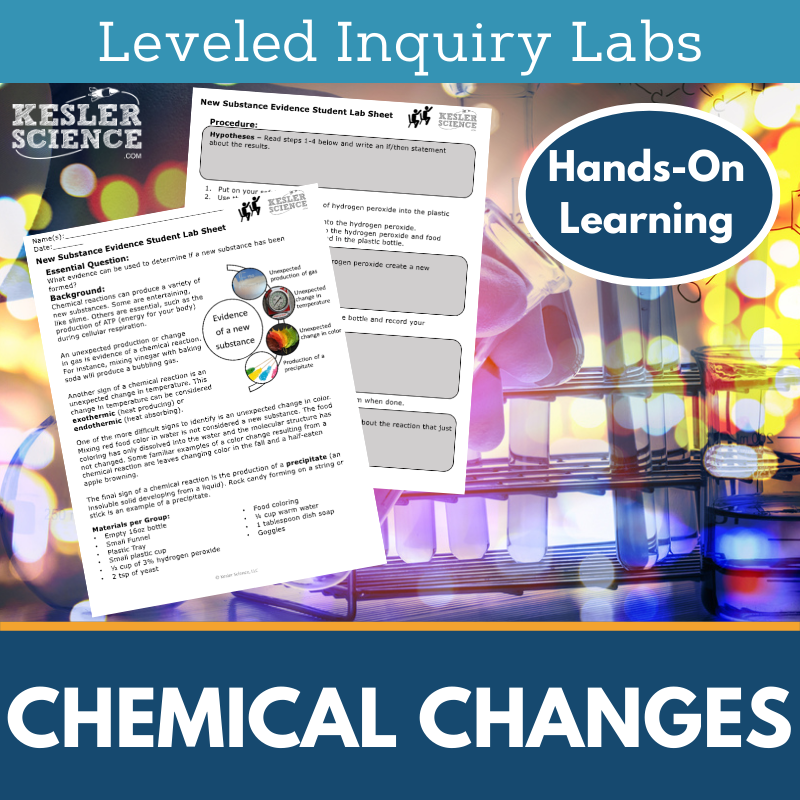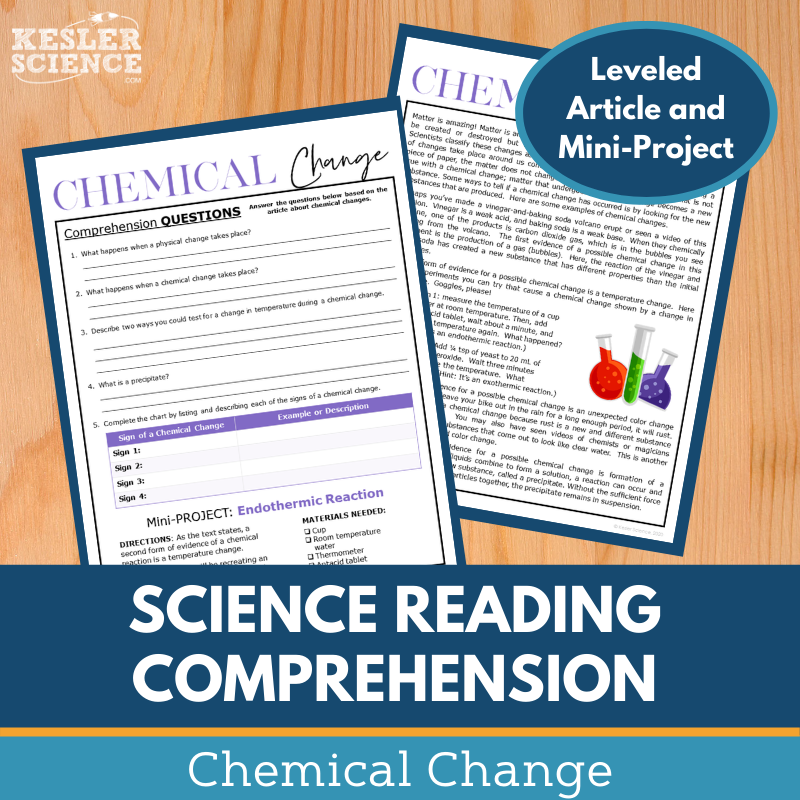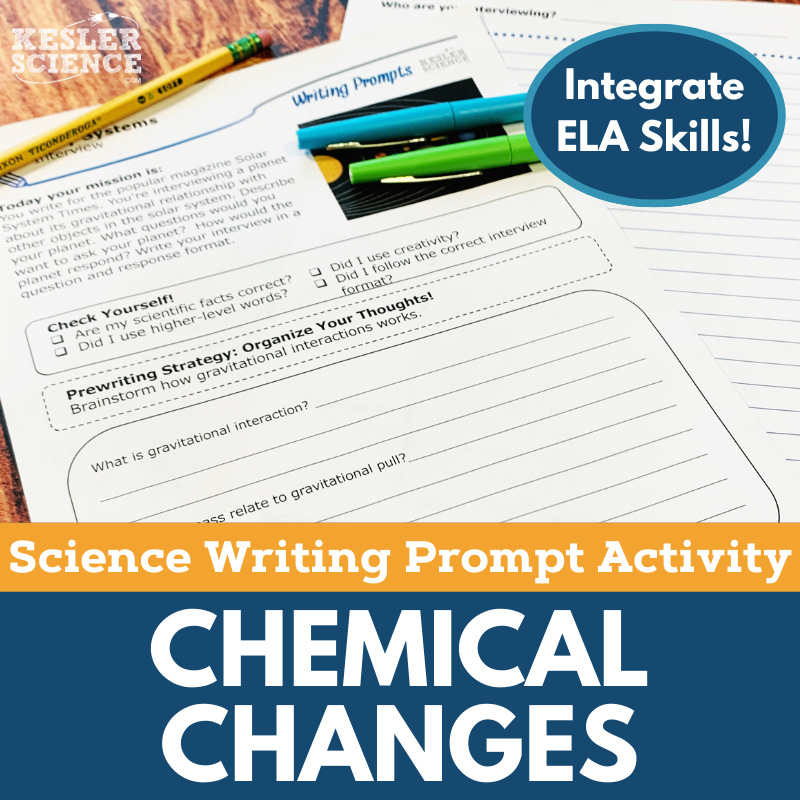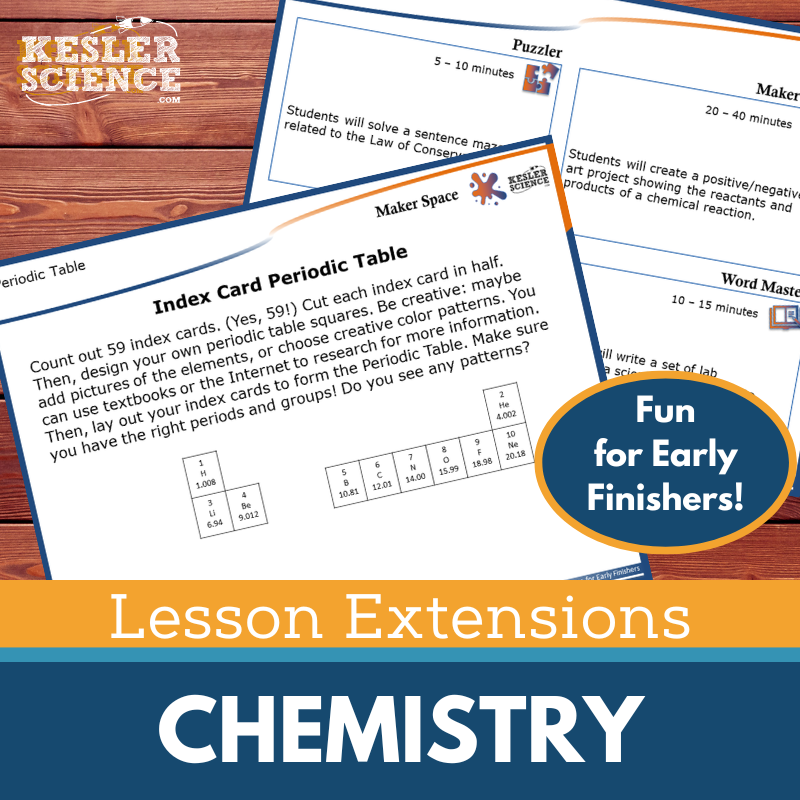Evidence of Chemical Changes Activities for Middle School Science
Students will explore the evidence of chemical changes with this engaging and comprehensive 5E lesson aligned to TEKS 6.6E. The resources below will give students a comprehensive understanding of chemical changes. All of the following materials are also included in the Kesler Science Membership.
The Kesler Science Evidence of Chemical Changes 5E Lesson is a comprehensive middle school chemistry unit designed to help students recognize evidence of chemical changes. It includes editable presentations, worksheets, student-choice projects, and assessments, all structured within a low-prep, differentiated, and student-led format. The lesson aligns with TEKS 6.6E and supports multimodal learning with Spanish translations available for key materials.
Following the 5E Model, the unit begins with engaging discussions and activities to introduce chemical changes. The hands-on, student-led station lab in the Exploration phase offers nine stations, including hands-on experiments, reading comprehension, video analysis, and categorization tasks. The Explanation phase provides editable PowerPoints, interactive notebooks, and note-taking templates. Students extend their learning through choice projects in the Elaboration phase and demonstrate understanding with STAAR 2.0-aligned assessments in the Evaluation phase.
The lesson is flexible for both in-person and virtual learning, with printable and digital formats available. Interactive and differentiated resources ensure accessibility for all learners, making this a thorough and engaging approach to teaching chemical changes in middle school science.
The Kesler Science Evidence of Chemical Changes 5E Lesson is a comprehensive middle school chemistry unit designed to help students recognize evidence of chemical changes. It includes editable presentations, worksheets, student-choice projects, and assessments, all structured within a low-prep, differentiated, and student-led format. The lesson aligns with TEKS 6.6E and supports multimodal learning with Spanish translations available for key materials.
Following the 5E Model, the unit begins with engaging discussions and activities to introduce chemical changes. The hands-on, student-led station lab in the Exploration phase offers nine stations, including hands-on experiments, reading comprehension, video analysis, and categorization tasks. The Explanation phase provides editable PowerPoints, interactive notebooks, and note-taking templates. Students extend their learning through choice projects in the Elaboration phase and demonstrate understanding with STAAR 2.0-aligned assessments in the Evaluation phase.
The lesson is flexible for both in-person and virtual learning, with printable and digital formats available. Interactive and differentiated resources ensure accessibility for all learners, making this a thorough and engaging approach to teaching chemical changes in middle school science.
Engage your students with this modular, student-led station lab aligned with TEKS 2021 standard 6.6E. Designed for in-class or virtual learning, this activity helps students identify the formation of a new substance using evidence of chemical changes, including gas production, thermal energy changes, precipitate formation, and color change.
Students take an active role in their learning through nine differentiated stations featuring videos, readings, research, and hands-on activities. Input stations introduce concepts through experiments, videos, reading passages (available in English and Spanish), and research tasks. Output stations reinforce learning through organization tasks, illustrations, written responses, and assessments. A bonus challenge station offers extension activities such as crosswords, games, and mini projects.
This low-prep, high-engagement resource promotes active learning and critical thinking in physical science chemistry lessons.
Engage your students with this modular, student-led station lab aligned with TEKS 2021 standard 6.6E. Designed for in-class or virtual learning, this activity helps students identify the formation of a new substance using evidence of chemical changes, including gas production, thermal energy changes, precipitate formation, and color change.
Students take an active role in their learning through nine differentiated stations featuring videos, readings, research, and hands-on activities. Input stations introduce concepts through experiments, videos, reading passages (available in English and Spanish), and research tasks. Output stations reinforce learning through organization tasks, illustrations, written responses, and assessments. A bonus challenge station offers extension activities such as crosswords, games, and mini projects.
This low-prep, high-engagement resource promotes active learning and critical thinking in physical science chemistry lessons.
The Evidence of Chemical Changes Student Choice Projects align with the 2021 TEKS standard 6.6E, giving middle school students the flexibility to choose a project that suits their preferred output style. A project page outlines six student-led options plus a “design your own” project, all supported by an editable rubric for teacher, peer, or self-assessment. This resource is also included in the Evidence of Chemical Changes Complete Lesson for TEKS 6.6E.
These multimodal projects allow students to demonstrate their understanding in creative ways. Two versions of the project page provide differentiation, with modified options for students needing remediation and challenge options for advanced learners. Teachers can adjust the rubric to fit grading needs.
The projects require standard classroom supplies such as paper, markers, and scissors, with many options available for digital completion.
The Evidence of Chemical Changes Student Choice Projects align with the 2021 TEKS standard 6.6E, giving middle school students the flexibility to choose a project that suits their preferred output style. A project page outlines six student-led options plus a “design your own” project, all supported by an editable rubric for teacher, peer, or self-assessment. This resource is also included in the Evidence of Chemical Changes Complete Lesson for TEKS 6.6E.
These multimodal projects allow students to demonstrate their understanding in creative ways. Two versions of the project page provide differentiation, with modified options for students needing remediation and challenge options for advanced learners. Teachers can adjust the rubric to fit grading needs.
The projects require standard classroom supplies such as paper, markers, and scissors, with many options available for digital completion.
The Chemical Reactions Inquiry Lab aligns with TEKS, helping students identify the formation of a new substance by recognizing evidence of a chemical change, such as gas production, temperature change, precipitate formation, or color change.
This resource includes three differentiated labs to support various learning levels. The Dependent Student Lab provides guided inquiry with procedural instructions, ideal for on-level learners. The Modified Student Lab offers a structured experience with sentence stems and multiple-choice questions for students needing modifications. The Independent Student Lab encourages advanced learners to take control of the investigation with minimal guidance.
Teacher resource pages outline preparation, standards, objectives, directions, materials, and additional resources. Editable CER conclusion and reflection questions guide students through claim, evidence, and reasoning statements. Answer keys are included for easy grading.
Using common classroom materials like hydrogen peroxide, yeast, dish soap, and food coloring, students engage in a hands-on exploration of chemical reactions while observing the formation of a new substance.
The Chemical Reactions Inquiry Lab aligns with TEKS, helping students identify the formation of a new substance by recognizing evidence of a chemical change, such as gas production, temperature change, precipitate formation, or color change.
This resource includes three differentiated labs to support various learning levels. The Dependent Student Lab provides guided inquiry with procedural instructions, ideal for on-level learners. The Modified Student Lab offers a structured experience with sentence stems and multiple-choice questions for students needing modifications. The Independent Student Lab encourages advanced learners to take control of the investigation with minimal guidance.
Teacher resource pages outline preparation, standards, objectives, directions, materials, and additional resources. Editable CER conclusion and reflection questions guide students through claim, evidence, and reasoning statements. Answer keys are included for easy grading.
Using common classroom materials like hydrogen peroxide, yeast, dish soap, and food coloring, students engage in a hands-on exploration of chemical reactions while observing the formation of a new substance.
The Physical and Chemical Changes Escape Room is an interactive experience where students apply their understanding of chemical and physical changes. Aligned with TEKS and NGSS, this activity challenges students to compare and contrast these concepts in an engaging way.
Teachers have full control over the eight independent puzzles, allowing customization based on time constraints and student needs. The escape room can be conducted using manila envelopes and included materials or enhanced with locks and a storage box for a more authentic experience. Digital versions are available via PowerPoint or Google Slides, with printable options for home use.
The resource includes teacher directions, answer keys, digital tools, editable templates, and a Google Form answer sheet. Students will engage with video challenges, reward templates, and interactive props, making this an unforgettable learning experience.
The Physical and Chemical Changes Escape Room is an interactive experience where students apply their understanding of chemical and physical changes. Aligned with TEKS and NGSS, this activity challenges students to compare and contrast these concepts in an engaging way.
Teachers have full control over the eight independent puzzles, allowing customization based on time constraints and student needs. The escape room can be conducted using manila envelopes and included materials or enhanced with locks and a storage box for a more authentic experience. Digital versions are available via PowerPoint or Google Slides, with printable options for home use.
The resource includes teacher directions, answer keys, digital tools, editable templates, and a Google Form answer sheet. Students will engage with video challenges, reward templates, and interactive props, making this an unforgettable learning experience.
The Chemical Change Science Reading Comprehension Lesson helps students explore the formation of new substances through evidence of chemical change. They will read a nonfiction article, answer comprehension questions, and recreate an endothermic reaction to deepen their understanding.
Designed for middle school students (grades 6-8, with higher-level 5th graders), the resource includes a leveled science passage (Lexile 1100-1300), five to seven comprehension questions, and a hands-on mini-project. A Cornell notes template is provided for structured note-taking. The article features engaging visuals that print well in grayscale.
This resource supports both in-person and virtual learning through platforms like Google Classroom, MS Teams, Schoology, and Canvas. Students can complete assignments digitally using a PowerPoint file or Google Slides. Ideal for sub plans, ISS, extra credit, or whole-class instruction, this lesson fosters science literacy, critical thinking, and classroom discussions on chemical changes.
The Chemical Change Science Reading Comprehension Lesson helps students explore the formation of new substances through evidence of chemical change. They will read a nonfiction article, answer comprehension questions, and recreate an endothermic reaction to deepen their understanding.
Designed for middle school students (grades 6-8, with higher-level 5th graders), the resource includes a leveled science passage (Lexile 1100-1300), five to seven comprehension questions, and a hands-on mini-project. A Cornell notes template is provided for structured note-taking. The article features engaging visuals that print well in grayscale.
This resource supports both in-person and virtual learning through platforms like Google Classroom, MS Teams, Schoology, and Canvas. Students can complete assignments digitally using a PowerPoint file or Google Slides. Ideal for sub plans, ISS, extra credit, or whole-class instruction, this lesson fosters science literacy, critical thinking, and classroom discussions on chemical changes.
The Chemical Changes Science Writing Prompt Activity engages middle school students in a song-based writing exercise to reinforce their understanding of chemical changes. Aligned with TEKS, this creative, low-prep activity helps students identify the formation of new substances through evidence such as gas production, temperature change, precipitate formation, or color change. Designed for both in-person and virtual learning, this resource supports science reasoning and exploration while enriching student writing.
This activity includes teacher directions with answer guides, project ideas, and rubrics. It offers full-sized and half-sheet handouts with writing prompts, student self-checks, and pre-writing strategies. A projection version allows for easy classroom display, while a digital interactive PowerPoint version can be used in Google Slides for remote learners.
Ideal for cross-curricular activities, pre-test assessments, student choice projects, early finisher enrichment, extra credit, make-up work, and differentiation, this writing prompt fosters engagement and creativity. It also works well as a TELPAS sample and can be displayed on a bulletin board or compiled into a student anthology.
The Chemical Changes Science Writing Prompt Activity engages middle school students in a song-based writing exercise to reinforce their understanding of chemical changes. Aligned with TEKS, this creative, low-prep activity helps students identify the formation of new substances through evidence such as gas production, temperature change, precipitate formation, or color change. Designed for both in-person and virtual learning, this resource supports science reasoning and exploration while enriching student writing.
This activity includes teacher directions with answer guides, project ideas, and rubrics. It offers full-sized and half-sheet handouts with writing prompts, student self-checks, and pre-writing strategies. A projection version allows for easy classroom display, while a digital interactive PowerPoint version can be used in Google Slides for remote learners.
Ideal for cross-curricular activities, pre-test assessments, student choice projects, early finisher enrichment, extra credit, make-up work, and differentiation, this writing prompt fosters engagement and creativity. It also works well as a TELPAS sample and can be displayed on a bulletin board or compiled into a student anthology.
The WIKI Tickets© Formative Assessments provide engaging, flexible ways to check student understanding in 6th-8th grade science. This Chemistry Set includes 14 assessments, each available in five formats: a full-screen projection version, three print handouts, and a digital interactive version compatible with PowerPoint and Google Slides.
Aligned with NGSS and TEKS standards, these assessments cover key topics such as atomic structure, chemical changes, density, periodic table arrangement, and recognizing chemical reactions. Each standard has at least one ticket, with some topics featuring multiple assessments. A table of contents file is included to show alignment.
Designed for both in-person and virtual learning, WIKI Tickets© can be used as exit tickets, bellringers, or quick checks. Students can respond on paper, printed handouts, or digitally on their own copies of the interactive files. These colorful assessments provide a versatile, ready-to-use resource to gauge student progress effectively.
The WIKI Tickets© Formative Assessments provide engaging, flexible ways to check student understanding in 6th-8th grade science. This Chemistry Set includes 14 assessments, each available in five formats: a full-screen projection version, three print handouts, and a digital interactive version compatible with PowerPoint and Google Slides.
Aligned with NGSS and TEKS standards, these assessments cover key topics such as atomic structure, chemical changes, density, periodic table arrangement, and recognizing chemical reactions. Each standard has at least one ticket, with some topics featuring multiple assessments. A table of contents file is included to show alignment.
Designed for both in-person and virtual learning, WIKI Tickets© can be used as exit tickets, bellringers, or quick checks. Students can respond on paper, printed handouts, or digitally on their own copies of the interactive files. These colorful assessments provide a versatile, ready-to-use resource to gauge student progress effectively.
Lesson Extensions provide engaging, student-choice activities designed to challenge early finishers and deepen their understanding of chemistry standards. These activities help fill downtime, reinforce critical thinking, and keep students engaged with rigorous yet enjoyable learning opportunities. Aligned to NGSS and TEKS, they offer high-level enrichment for independent learners.
Each extension includes four interactive components: Puzzler for problem-solving, Maker Space for hands-on STEAM activities, Tech Connection for digital demonstrations, and Word Master for creative writing. Teacher directions, answer keys, projection versions for digital boards, and printable formats ensure easy implementation. Covering topics such as atomic structures, chemical reactions, the periodic table, and synthetic materials, these extensions provide a dynamic way to wrap up lessons and keep students actively learning.
Lesson Extensions provide engaging, student-choice activities designed to challenge early finishers and deepen their understanding of chemistry standards. These activities help fill downtime, reinforce critical thinking, and keep students engaged with rigorous yet enjoyable learning opportunities. Aligned to NGSS and TEKS, they offer high-level enrichment for independent learners.
Each extension includes four interactive components: Puzzler for problem-solving, Maker Space for hands-on STEAM activities, Tech Connection for digital demonstrations, and Word Master for creative writing. Teacher directions, answer keys, projection versions for digital boards, and printable formats ensure easy implementation. Covering topics such as atomic structures, chemical reactions, the periodic table, and synthetic materials, these extensions provide a dynamic way to wrap up lessons and keep students actively learning.
This Amazing Anchors Phenomenon Lesson engages students in chemical reactions through the real-world example of the Statue of Liberty’s color change. It includes an introductory reading with comprehension and extension questions, followed by an explanatory reading that simplifies the science behind chemical reactions, reinforcing learning with additional questions.
Aligned with TEKS, this no-prep resource includes teacher directions, answer keys, projection slides, and both print and digital formats for flexible use in Google Classroom or other platforms. A modified version with differentiated language and sentence starters supports diverse learners. Designed to bookend a lesson, these readings serve as valuable supplements to any middle school science curriculum.
This Amazing Anchors Phenomenon Lesson engages students in chemical reactions through the real-world example of the Statue of Liberty’s color change. It includes an introductory reading with comprehension and extension questions, followed by an explanatory reading that simplifies the science behind chemical reactions, reinforcing learning with additional questions.
Aligned with TEKS, this no-prep resource includes teacher directions, answer keys, projection slides, and both print and digital formats for flexible use in Google Classroom or other platforms. A modified version with differentiated language and sentence starters supports diverse learners. Designed to bookend a lesson, these readings serve as valuable supplements to any middle school science curriculum.
Year-Round Resources
These year-round activities will increase your students' understanding of many middle school science topics. All of these activities are also included in the Kesler Science Membership.
Visual Data & Graphing
You're not alone if your students struggle with understanding graphs, charts, and tables. It's a skill that takes an enormous amount of practice. This resource will help students build a strong foundation in analyzing data and creating their own data visualizations.
Bell Ringers and Warm-Ups
These middle school science bell ringers are an excellent way to engage your students as soon as they walk into your classroom. This comprehensive FULL YEAR resource includes everything you need to start off each science class with an interesting warm-up activity.
Review Board Games
Each game board has been carefully designed to keep students engaged. There are 10 different action spaces on each board and dozens of question cards. All of the actions are related to science concepts and keep the students motivated throughout the game.
Each game is ready to play. Simply print out the board and the cards and let the students enjoy reviewing nine different units.
Essential Questions and Standards
Below are the essential questions and standards associated with the lessons and activities included in the atoms unit. This topic is only one of more than 100 middle school science topics included in the Kesler Science Membership.
-
How does a possible chemical change help to identify the formation of a new substance?
-
How can we identify and describe examples of evidence of a possible chemical change?
-
TEKS Science - 6.6E Evidence of Chemical Changes
Kesler Science Membership
Imagine never having to search for another middle school science lesson again. The membership gives you access to ALL of the Kesler Science products in one place (Yes, including everything above).
Say goodbye to long hours of lesson prep.





















